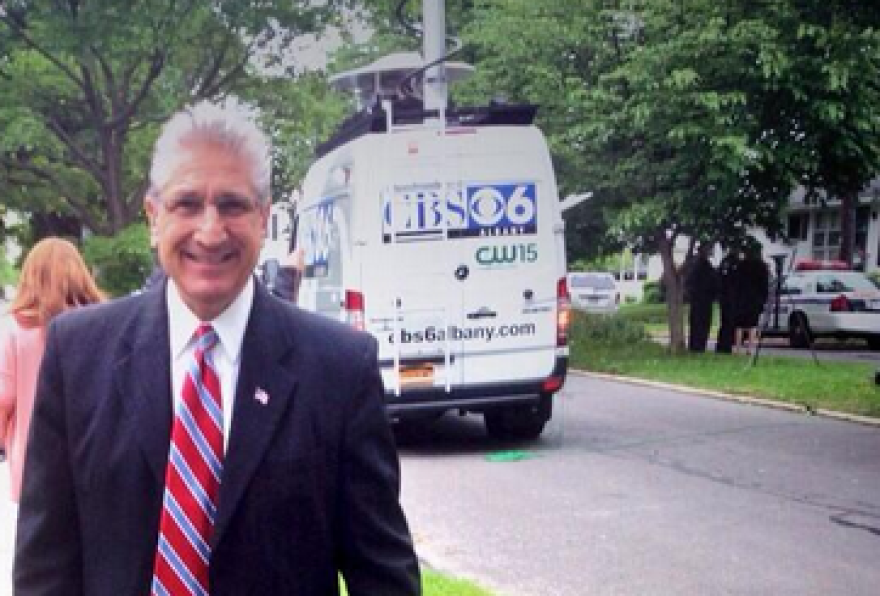A bear cub that took refuge in a tree across the street from a public school in an Albany neighborhood captivated the city for more than a day, the story attracting national attention and stirring a mini-debate over euthanization. There is no happy ending.
The young black bear wandered far from home, survived being hit by two cars and shot with tranquilizer darts and a shotgun before finally falling from a tree where it sought refuge in a city neighborhood.
The approximately 175-pound cub was first spotted early Tuesday in the Bethlehem area and again at nearby Exit 23 on the Thruway. Officials say at some point, it was hit by two cars. After several sightings, the bear was shot with tranquilizer darts and later a shotgun, then found refuge more than 50 feet up a tree behind a home off Whitehall Road near Meyers Middle School. A crowd of onlookers descended on the scene.
Time Warner Cable News reporter Maria Valvanis was with one of the local TV crews on “bearwatch” "We were covering the bearwatch yesterday and some of Tuesday as well. It was one of the busiest stories we've ever had the chance to cover, both at the scene and on social media. I'm pretty sure we all broke a tweeting record yesterday. There were four or five seperate hashtags and twitter accounts set up for the bear."
The bear incident coincided with Animal Advocacy Day at the state capitol.

Assemblywoman Pat Fahy and Assemblyman Jim Tedisco of the Capital District joined a call sparked by a group of neighborhood children demanding the Department of Environmental Conservation capture and release the bear without causing further harm. Tedisco balanced the blame between bear and civilization. "This isn't just the case where a wild animal like the bear is encroaching on human's habitat. This is a case where probably humans have encroached on a wild bear's habitat and then that bear moved into their habitat, and it sends a message to us. We have to keep our forest land. We have to keep some separation. God does not create junk. Yes, this is a wild animal but it adds to the quality of life to have these wonderful species in our society, so we have to be careful about leaving some open space."
Unfortunately, the bear, who hailed from Pennsylvania, was already a two-time loser, having been tagged after previous encounters with people. And, Fahy admitted, things didn't look good for the interloper. "The policy is to euthanize a bear when it's moved into densely populated areas this often, and this is the third time.”
The Department of Environmental Conservation decided the bear would be killed at a nearby state wildlife center. DEC's Larry Bifaro says eutahnization was a last resort. "Once the bear was on the ground we were able to assess its injuries from the previous day. It had a very large open wound and we determined that for humane purposes, and because of its past nuisance behavior, that we were going to have to euthanize it."

Dan Persing, a partner at Albany law firm Tully Rinckey, says there could have been a liability issue had the DEC released a feral animal known to have a propensity to wander. "There is an element of protection but there's also somewhat of an immunity given to officials for that reason because that is a feral animal, it's not owned, it's not domesticated, and so we have a different set of rules for that. And it probably would have to be tested as to whether they released it too close to a residential area or otherwise and see whether they actually violated any policy. If policy has been followed, that they generally do put down animal that has wandered too closely into a residential population and then deviate from that policy, there has to be a good reason because policy can be example of a standard. If they breach that standard, then that could constitute the definition of negligence."
The DEC tags relocated bears so it can track their movements. Watch Maria Valvanis' television news report.
May 27 Bear Timeline (Courtesy NYS DEC):
- DEC received a call Tuesday at 6:24 a.m. about a bear spotted in Bethlehem in the vicinity of Old Rt. 9W. The bear reportedly had double ear tags, which means he had previous encounters with wildlife biologists.
- DEC received a second call at approximately 8:45 a.m. about a bear spotted at the toll booth on I787 at exit 23. This bear, which reported was hit by a car twice, ran into a wooded area between I787 and the residential area on Morton Avenue.
- DEC also received reports of bear activity in neighborhoods in Bethlehem over the weekend. The bear attempted to get into a garage and damaged tents.
- Tuesday afternoon the bear with double ear tags resurfaced on Rose Court in Albany. The bear's history over the weekend demonstrates it is a dangerous bear with a pattern of aggressive behavior and poses a threat to public safety. Because of his dangerous behavior and injuries already sustained, the most appropriate course of action is to put the bear down.
- DEC officers tracked the bear to a ravine where officers could safely attempt to put the bear down in a secluded area. The wound was not mortal and the bear escaped the ravine and ran up a tree where it remained overnight.
- DEC, with the assistance of the Albany Police Department, cleared the area around the tree and closed it off.
- DEC tranquilized and retrieved. The bear was then transported to DEC's Wildlife Center in Delmar.
NYS DEC Tips to Discourage Bear Activity:
- Never approach or surround a bear - Bears aggressively defend themselves when they feel threatened. Be especially cautious around cubs as mother bears are very protective.
- Avoid walking trails at night - Stay in your campsite to avoid chance encounters.
- Use noise to scare bears - Yell, clap or bang pots immediately upon sighting a bear.
- Never run from a bear - If you feel threatened, back away slowly.
- Do not throw objects or food at an approaching Bear - This practice will only encourage bears to approach and "bully" people to get food.
Report a black bear sighting by calling DEC at: (518) 408-5852.





